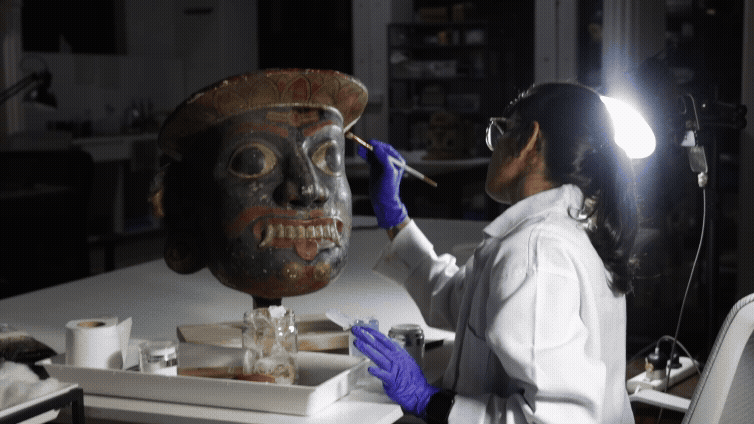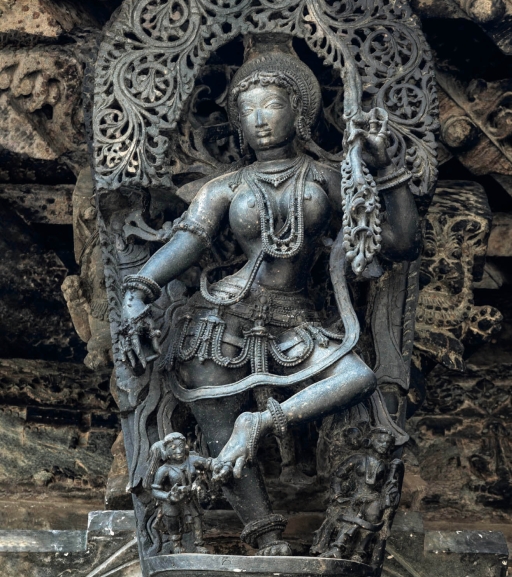News and Updates
The latest from the Deccan Heritage Foundation
Browse our newsletters, and stay current on the latest announcements regarding our projects, publications, and events.
“Preserving History: Temples, Mansions, Stepwells, and Deccani Traditions”

As 2025 draws to a close, the Deccan Heritage Foundation (DHF) is proud to share what the generosity of our friends and patrons has made possible this year. From restoring world-class historic sites and preserving important artefacts to partnering with educational institutions and publishing new books, our work across the Deccan continues to grow in scale and impact.
None of this would be possible without people like you. If you believe in safeguarding the Deccan’s extraordinary built heritage, we invite you to make a gift today to support our work in 2026.
Banner image: Krishna lifting Govardhana Hill, Hoysaleshvara Temple, Halebidu, Karnataka. Photograph by Surendra Kumar.
Restoration Projects
Jayalakshmi Vilas Mansion & Folklore Museum

Jayalakshmi Vilas Mansion & Museum, Mysuru. Photograph by Maniyarasan R.
2025 marked major progress at our landmark project, Jayalakshmi Vilas Mansion (JVM) in Mysuru. With a cornerstone multi-year grant from the Harish & Bina Shah Foundation, alongside support from the U.S. Ambassadors Fund for Cultural Preservation, the DHF has advanced structural restoration and cataloguing of the mansion’s remarkable folklore collection.

Conserving a Somana Kunitha mask, Conservation Lab, Jayalakshmi Vilas Mansion & Museum, Mysuru. Video by Maniyarasan R.
Additional funding from Ashish and Manisha Dhawan of the Aikyam Foundation has enabled the establishment of the upcoming Manisha Dhawan Learning Centre for Conservation, a pioneering new department for restoration and photography. Once complete, JVM will re-open as a contemporary museum and a national model for sustainable heritage management in partnership with the University of Mysore.
Nagakunda Stepwell

The Nagakunda stepwell in Sudi. Photograph by Surendra Kumar.
Sudi’s 1,000-year-old Nagakunda Stepwell, along with a cluster of adjacent medieval monuments, has now been fully restored under the Government of Karnataka’s ‘Adopt a Monument’ scheme. This has been made possible with the generous support from the Devineni family in memory of Dr. Devineni Subba Rao, channelled through the Gandipet Welfare Society (GWS), a Hyderabad-based NGO committed to zero-waste initiatives that will continue to maintain the site.
With this phase now complete, the DHF is preparing to begin work on the next set of monuments in Sudi, which is poised to grow into a significant cultural destination within a sustainable heritage corridor linking Badami and Hampi.
The British Residency


Before & After Restoration of the Rang Mahal gate by the Deccan Heritage Foundation.
Following the restoration of the Rang Mahal pavilion and gardens, the DHF continues work across the historic Residency Complex, now home to the Veeranari Chakali Ilamma Women’s University (formerly known as Koti Women’s College), a powerful example of adaptive re-use. This year, with support from ADVA Enviro Solutions Pvt. Ltd. (The Rainwater Project), we completed the partial restoration of the Physics Block and began the conservation of a rare underground stepwell, where stabilisation of old masonry and clearing of invasive vegetation are currently underway.
We are now preparing the next phase of conservation, which will focus on three key heritage zones within the former Residency Complex: the kabutarkhana (pigeon house), the baggikhana (carriage house), and former residential quarters. This new phase will build on ongoing restoration efforts and continue to strengthen the architectural and educational fabric of the campus.
Deccani Studies Program

The inaugural batch of the Deccani Studies Program, Hoysaleshvara Temple, Halebidu, Karnataka. Photograph by Marika Sardar.
With support from the Harish & Bina Shah Foundation and Ashoka University, we launched the first edition of the Deccani Studies Program, a four-week immersion that commenced in Warangal and concluded at the Jayalakshmi Vilas Mansion and the University of Mysore.
Students explored the region’s layered histories through site visits, workshops, and hands-on conservation training. The pilot exceeded all expectations: one of the students’ projects was acknowledged by the Government of Karnataka, and four students were selected for internships at Factum Arte in London and Madrid.
The program will now become a recurring summer course, helping train the next generation of Deccan scholars and heritage practitioners. To ensure deserving students can participate, the DHF is establishing a Scholarship Fund:
- USD 3,500 – supports one student for the full Deccani Studies Program
- USD 2,000 – supports a one-month internship at Jayalakshmi Vilas Mansion
Looking Forward…
- Book Launch: Vijayanagara: City of Victory – launching January
- Book Launch: Lakkundi Guidebook – releasing January
- Rang Mahal Complex – next phase of fundraising and restoration
- Scholarship for the Deccani Studies Program – fundraising underway
Thank you for your continued engagement with the DHF. We look forward to sharing more of our work to preserve the Deccan’s rich heritage with you in 2026.
Your gift today will help us begin the new year with strong momentum and work towards preserving the Deccan’s rich heritage for future generations.
Previous Newsletters and updates

